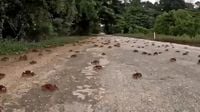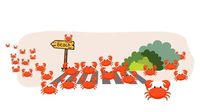Every year, a truly remarkable spectacle unfolds on Christmas Island, a remote territory in the Indian Ocean more than 1,200 miles northwest of mainland Australia and not far from the Indonesian island of Java. In late October 2025, the island once again became the scene of one of the planet’s largest and most astonishing animal migrations: the red crab migration. According to Christmas Island National Park officials and widely reported by outlets including SBS Filipino, millions—some estimates say around 50 million—of these vivid crimson crustaceans emerged from their burrows and began their synchronized trek to the ocean to breed.
The migration, which began on October 23 and 24 this year with the first rainfall of the wet season, is triggered by the arrival of the monsoon rains in the Southern Hemisphere. This timing is not random; the early seasonal rains help prevent the crabs from dehydrating during their arduous journey. As the forest floor becomes damp, the crabs—who spend most of the year hidden away in solitary burrows—emerge en masse, transforming the island’s landscape into a moving red carpet. The migration is so vast and overwhelming that, as reported by Christmas Island National Park and highlighted in coverage by SBS Filipino, residents and visitors alike must watch their step to avoid accidentally crushing the tiny travelers. One islander, filming the scene, could be heard warning, "Just don’t step on the little guys, but they are everywhere."
But why do these crabs undertake such a perilous journey each year? The answer lies in their unique reproductive cycle. The migration is a race against time and the elements, carefully choreographed to coincide with the lunar cycle. As explained by local officials and detailed in a recent SBS Filipino broadcast, the crabs must reach the ocean at just the right moment: the last quarter of the moon, when high tides create optimal conditions for egg release. During this period, the crabs’ chances of successful reproduction are greatest, as the eggs can be cast directly into the sea, where the larvae will hatch and spend their earliest days before returning to shore as young crabs.
The migration itself is a marvel of natural engineering and community cooperation. Male crabs are the first to leave their burrows, leading the charge toward the ocean. Once they arrive at the lower terraces of the island, they dig burrows in the sand. Females soon follow, joining the males in or near these burrows, where mating takes place. After mating, the males return inland, while the females linger at the coast, each capable of producing up to 100,000 eggs. At the appointed high tide, the females venture from their burrows and, in a dramatic moment, release their eggs into the swirling surf. With their mission complete, the females then begin the long trek back to their forest homes.
For the people of Christmas Island, the migration is both a logistical challenge and a cherished tradition. The sheer number of crabs—50 million, by some estimates—can bring daily life to a crawl. Roads are often closed for days at a time, and special “crab bridges” and tunnels have been constructed to help the crabs cross busy areas safely. According to reports from Christmas Island National Park, these protective measures are essential: without them, countless crabs would fall victim to traffic or become stranded on hot pavement. Locals have even been known to use leaf blowers and garden rakes to gently nudge the crabs along their route, a testament to the community’s respect for their tiny, red neighbors.
Beyond its visual spectacle, the red crab migration is a critical ecological event for Christmas Island’s rainforest. Red crabs are omnivores, feeding on fallen leaves, fruits, and even the occasional dead crab. By consuming this organic litter, they help to turn and fertilize the soil, playing a vital role in maintaining the health of the island’s ecosystem. For most of the year, red crabs live solitary lives, fiercely defending their burrows from rivals and emerging only when the conditions are just right. They reach sexual maturity around four to five years of age, at which point they join the annual migration.
The journey is not without its hazards. The crabs must scuttle over rocks, through dense forest, and across open roads—terrain that’s treacherous for such small, moisture-dependent creatures. Dehydration is a constant threat, which is why the timing of the migration with the wet season is so crucial. Christmas Island’s officials have long recognized the importance of protecting the crabs, not only for their own sake but for the island’s broader ecological balance. Road closures and crab crossings are now a familiar part of island life every spring, and the community’s efforts have become an integral part of the migration’s success.
Media coverage of the 2025 migration has brought renewed global attention to this natural wonder. On October 26, SBS Filipino aired a special program explaining the science and spectacle behind the migration, available across radio, TV, and streaming platforms. The program delved into the details of the crabs’ journey, the challenges they face, and the ways in which the island’s residents have adapted to their annual visitors. As the broadcast explained, the sight of millions of crabs moving in unison is not just a local curiosity—it’s a reminder of the intricate connections between species, climate, and community.
For those lucky enough to witness the migration firsthand, it’s an unforgettable experience. The island’s forests, roads, and beaches are transformed by the steady, purposeful movement of the crabs, each one driven by instinct and the promise of new life. As one observer put it, “They are everywhere.” It’s a phrase that captures both the scale of the migration and the sense of wonder it inspires.
In a world where so many natural phenomena are threatened by climate change and human activity, the red crab migration of Christmas Island stands out as a testament to resilience and adaptation. Thanks to the concerted efforts of local officials, conservationists, and the island’s residents, this extraordinary journey continues, year after year, turning a small island in the Indian Ocean into the stage for one of nature’s greatest shows.


